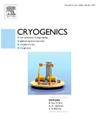Modelling the thermal buffer behavior of JT-60SA in case of pulsed heat loads
IF 1.8
3区 工程技术
Q3 PHYSICS, APPLIED
引用次数: 0
Abstract
JT-60SA is a joint international fusion experiment built and operated by Japan and Europe in the framework of the Broader Approach agreement. Integrated commissioning held in 2021 and 2023 provided valuable experimental data, particularly a data set depicting the reaction of the cryogenic system to a Toroidal Field (TF) coil fast safety discharge (FSD). When a TF FSD occurs, the actual protocol imposes at high currents a disconnection of the TFC hydraulic circuit from the cryoplant and releases the heated and pressurized helium in a quench tank to avoid overpressure in the refrigerator and the magnet system. To shorten the time for cryoplant recovery, disconnection should be avoided in the absence of tripping risk for the whole cryoplant. In this regard, Simcryogenics modelling tool was used to represent the cryodistribution and simulate TF FSD and explore the possibility to avoid disconnecting the cryoplant after any TF FSD. One of the driving factors in the decision is the pressure rise observed in the buffer bath of the refrigerator during a FSD, preventing the Warm Compression Station (WCS) from being overloaded, otherwise inducing a severe tripping of the cryogenic system. In this paper, we present a model that reproduces the experimental signals of the buffer bath during and after controlled FSDs from 15, 18 and 20 kA and it also extrapolates for the nominal current of 25.7 kA. We conducted several parametric studies to explore the impact of some drivers of bath pressure rise: the increasing rate of the pressure setpoint and a mitigation of contributors to the total WCS mass flowrate. We show here some analysis and interpretations of the resulting trends obtained in the study and further conclude with a proposal path to manage the cryomagnet system during a nominal TF FSD avoiding disconnection.
模拟了JT-60SA在脉冲热负荷下的热缓冲性能
JT-60SA是一个由日本和欧洲在更广泛的方法协议框架内建造和运营的国际联合聚变实验。在2021年和2023年进行的综合调试提供了宝贵的实验数据,特别是描述低温系统对环形场(TF)线圈快速安全放电(FSD)反应的数据集。当TF FSD发生时,实际方案要求在大电流下断开TFC液压回路与低温装置的连接,并释放淬火罐中加热和加压的氦气,以避免冰箱和磁铁系统中的超压。为了缩短冷冻装置恢复的时间,应避免在整个冷冻装置没有跳闸风险的情况下断开连接。为此,使用Simcryogenics建模工具来表示低温分布并模拟TF FSD,并探索在任何TF FSD后避免断开冷冻装置的可能性。该决定的驱动因素之一是在FSD期间,在冷冻机缓冲槽中观察到压力上升,以防止温压缩站(WCS)过载,否则会导致低温系统严重跳闸。在本文中,我们提出了一个模型,该模型再现了缓冲液在15、18和20 kA控制fsd期间和之后的实验信号,并推断了25.7 kA的标称电流。我们进行了几项参数研究,以探索一些驱动槽压力上升的因素的影响:压力设定值的增加速率和WCS总质量流量的减缓。我们在这里展示了对研究中获得的结果趋势的一些分析和解释,并进一步总结了在名义TF FSD期间管理低温磁体系统以避免断开的建议路径。
本文章由计算机程序翻译,如有差异,请以英文原文为准。
求助全文
约1分钟内获得全文
求助全文
来源期刊

Cryogenics
物理-热力学
CiteScore
3.80
自引率
9.50%
发文量
0
审稿时长
2.1 months
期刊介绍:
Cryogenics is the world''s leading journal focusing on all aspects of cryoengineering and cryogenics. Papers published in Cryogenics cover a wide variety of subjects in low temperature engineering and research. Among the areas covered are:
- Applications of superconductivity: magnets, electronics, devices
- Superconductors and their properties
- Properties of materials: metals, alloys, composites, polymers, insulations
- New applications of cryogenic technology to processes, devices, machinery
- Refrigeration and liquefaction technology
- Thermodynamics
- Fluid properties and fluid mechanics
- Heat transfer
- Thermometry and measurement science
- Cryogenics in medicine
- Cryoelectronics
 求助内容:
求助内容: 应助结果提醒方式:
应助结果提醒方式:


